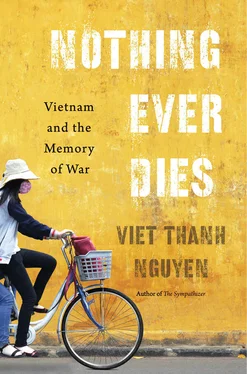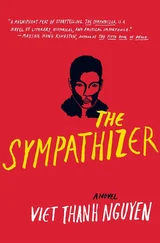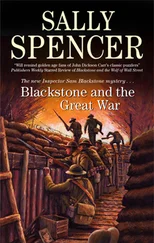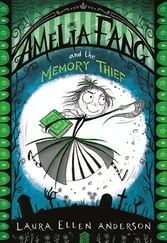The bulk of the War Memorial focuses on the south defending itself against the north, but a room after the main exhibits on the Korean War chronicle Korea’s “Expeditionary Forces.” Here, Vietnam is one of many countries that Korean troops have helped, including Japan, China, Kuwait, Somalia, Western Sahara, Georgia, India, Pakistan, Angola, and East Timor. After exiting the Expeditionary Forces exhibit, I concluded the tour by walking through displays of contemporary Korean weapons and uniforms, while videos celebrated the Korean Army’s professionalism and expertise. The memorial’s narrative is clear: after a brutal Korean War in which United Nations forces helped Koreans, the Korean Army learned how to defend the freedom of others in Vietnam. By doing so, contemporary Korea becomes a full-fledged member of the world’s first-rank nations, enjoying what the scholar Seungsook Moon calls “militarized modernity,” or the intertwined ways by which the country’s rise to global prominence is tied to its militarization, particularly in the standoff against North Korea. 5Is this martial modernity not what the war memorial embodies? Those impressive Korean armaments and vehicles, and the video screens that showed them, were manufactured by the Korean megacorporations known as chaebol . The cumulative effect was the simultaneous expression of Korean military, capitalist, and memorial power, a fearsome weaponized memory aimed at the tourist, me.
Still, the memorial provides the clues to unravel its own making, like the mysterious tag in one’s shirt that says Made in China, or Vietnam, or Cambodia, or Bangladesh. In the case of the memorial, that tag is the Expeditionary Forces room, which obliquely admits that what is commemorated in this room was Made in Korea. Despite its name, the room focuses mostly on the Korean war in Vietnam, as if the curators of the memorial simply could not excise that memory but had to include it in order to excuse it. One enters through a hallway decorated with jungle foliage, the classic sign of the country and the war. Photographs, dioramas, maps, and mannequins provide a historical account of some of the war’s events, its participants, and Korean and National Liberation Front bases of operation. In the background a soundtrack of rotating helicopter blades hums, a motif borrowed from Emile de Antonio and Francis Ford Coppola. In sharp contrast to the Korean War exhibits that revel in human sacrifice, from the struggles of refugees to the heroic soldiers who volunteered for suicide attacks, the Vietnam exhibit is remarkably bloodless. The mannequins dressed in enemy uniforms pose stiffly, the illustrations of booby traps are only technical, and the dioramas of guerilla tunnels present the everyday life of the Viet Cong rather than gut-wrenching combat.

The most dramatic image shows Korean soldiers disembarking from a Huey helicopter, familiar to any viewer of documentaries, movies, or news reports that show American soldiers doing the same. Here, though, the disembarkation happens in a glass-encased diorama with toy-sized figurines, as if created by very talented children for a school project (in the dioramas devoted to the Korean War, the human figures are life-size). Elsewhere the captions on photographs depicting South Korean soldiers — none in battle — read as public relations statements: “Korean forces in Vietnam also took great pride in improving public services and contributing to developmental projects. They earned a reputation for fairness and kindness among the Vietnamese people.” Or:
Through the dispatch of armed forces to Vietnam, we gained confidence and experience in building a more self-reliant defense force. It also increased the momentum of our economic development, strengthened the US commitment to the defense of the Republic of Korea, and solidified South Korea’s politico-military status vis-à-vis the United States. Furthermore, the impressive performance of the Korean forces in Vietnam enhanced our international reputation.
The perfect English of these statements is not to be dismissed. In most museums and memorials in Vietnam, Laos, and Cambodia during the postwar years until recently, the English was comically flawed, as if provided by one of Hollywood’s chop suey stereotypes. Precise translation and excellent curatorial work are simply further signs of Korea’s modernity. Still, these finely trained translators and curators cannot, or will not, deviate from their country’s dominant memory. So it is that the rest of the exhibits devoted to Vietnam recount how, after participating in a number of skirmishes and battles, all described in dry language, the South Korean soldiers “returned home in triumph.” This usually happens because soldiers vanquished the enemy, but the exhibit is silent about the heroism of these Korean troops. The exhibit is so reluctant to address Korean participation in combat that it does not even acknowledge the toil and trauma of Korean troops, much less that of Vietnamese enemies or civilians. Bringing up the heroic violence of Korean soldiers might dredge up their other, more embarrassing deeds. 6
While the United States waged the war to contain communism, this small exhibit contains that war’s implications for Korea. The most disturbing of those implications points to what Korean soldiers did during their forgotten war, which played a crucial role in Korea’s emergence as a subimperial power, as some scholars put it. 7Imperial powers conquer large swathes of the globe, while subimperial powers settle for regional domination. But even subimperial power can prove that one’s country and one’s people are not subhuman, but fully human. The paradoxical evidence of that humanity lies in one’s ability to bomb others, as Koreans can do now, versus being bombed by others, which is what happened to Koreans before they became subimperial. Subimperial power makes Korea’s War Memorial possible, but benevolent power is what this kind of memorial remembers (although those in power always remember themselves as being benevolent). This benevolent power allows one to defend one’s own country and other countries, versus having others defend or invade it. But one cannot own all the tanks, weapons, cannons, missiles, and other fine armaments on display in the War Memorial without using them, and one cannot use them without harming innocents or committing atrocities. Given its role as the bunker of state memory, expensive to build and just as expensive to maintain, the War Memorial will not and cannot acknowledge this reality of inhuman behavior on the part of its heroic soldiers.
If weaponized memory tends to be as costly as the state can afford, antiwar memory is affordable out of necessity. At most it will cost no more than people’s time and lives. Time and life, of course, are all that is required to write literature, and so it is no coincidence that two of the most notable efforts to counteract Korea’s weaponized memory are found in novels. The first is Hwang Suk-Yong’s The Shadow of Arms , published in two installments in 1985 and 1988. 8They appeared during two successive and repressive regimes led by presidents who served as army officers in Vietnam, Chun Doo Hwan and Roh Tae Woo. 9Given the political climate, the novel was daring, indicting the American presence in Vietnam as a source of utter corruption for all involved, including Koreans. The novel leaves no doubt that American-style capitalism and racism is at the heart of this war, waged not for a Pax Americana but for the American PX, the post exchange or military shopping mall. “What is a PX?” the novel asks. “A Disneyland in a vast tin warehouse,” the novel says. “A place where they sell the commodities used daily by a nation that possesses the skill to shower more than one million steel fragments over an area one mile wide by a quarter mile long with a single CBV.” What does the PX do? “The PX brings civilization to the filthy Asian slopeheads.” 10Even more than any tank or plane, the PX “is America’s most powerful new weapon.” 11While the PX is the military-industrial complex’s legitimate face, the black market is its illegitimate face. The black market welcomes everyone, including the communists and nationalists, and corrupts them with the benefits of a wartime economy inflated by American imports and dollars. The Vietnamese of all sides suffer because they cannot leave, unlike the Americans and the Koreans. These outsiders are what scholar Jinim Park calls “colonized colonizers,” the middlemen who help both the Americans and, inadvertently, the Japanese, who supply many of the goods for sale. 12“In Vietnam everything is Japanese.” 13So it is that Koreans learn a key lesson, which the Japanese, their former colonizers, already know: American wars in Asia can be profitable.
Читать дальше













